Business Law: Insolvency in Australia - Legal and Practical Aspects
VerifiedAdded on 2020/02/19
|10
|2673
|214
Report
AI Summary
This report provides a comprehensive overview of business law, specifically focusing on insolvency in the Australian context. It begins by defining insolvency and identifying key indicators, such as bank overdraft limits, inability to secure loans, and failure to pay creditors or employees. The report then explores the responsibilities of company directors when facing insolvency, emphasizing the need for proactive measures, including seeking financial and legal advice, and understanding the time-consuming nature of turnaround and restructuring processes. The report also delves into the legal obligations of directors under common law and the Corporations Act 2001 (Cth), including potential liabilities for insolvent trading, and provides defenses directors can use against such claims. Furthermore, the report examines the processes of voluntary and involuntary winding up, including the advantages and disadvantages of each, and discusses the role of the Australian Securities and Investments Commission (ASIC) in overseeing corporate insolvency. Finally, the report highlights topical issues faced by Australian companies in relation to insolvency, such as inadequate cash flow, poor strategic management, and preference payments.

Running head: BUSINESS LAW
Business Law
Name of the student
Name of the university
Author note
Business Law
Name of the student
Name of the university
Author note
Paraphrase This Document
Need a fresh take? Get an instant paraphrase of this document with our AI Paraphraser
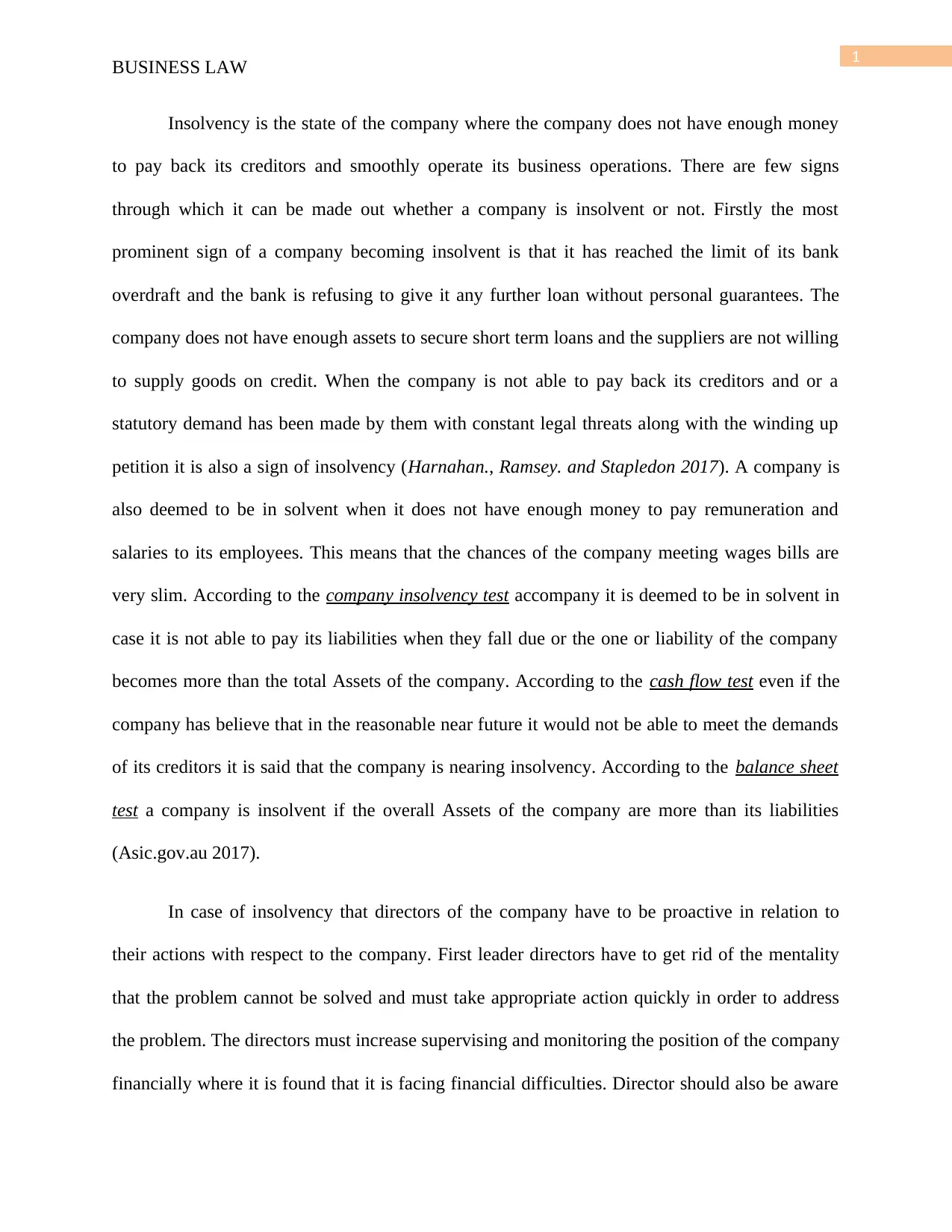
1
BUSINESS LAW
Insolvency is the state of the company where the company does not have enough money
to pay back its creditors and smoothly operate its business operations. There are few signs
through which it can be made out whether a company is insolvent or not. Firstly the most
prominent sign of a company becoming insolvent is that it has reached the limit of its bank
overdraft and the bank is refusing to give it any further loan without personal guarantees. The
company does not have enough assets to secure short term loans and the suppliers are not willing
to supply goods on credit. When the company is not able to pay back its creditors and or a
statutory demand has been made by them with constant legal threats along with the winding up
petition it is also a sign of insolvency (Harnahan., Ramsey. and Stapledon 2017). A company is
also deemed to be in solvent when it does not have enough money to pay remuneration and
salaries to its employees. This means that the chances of the company meeting wages bills are
very slim. According to the company insolvency test accompany it is deemed to be in solvent in
case it is not able to pay its liabilities when they fall due or the one or liability of the company
becomes more than the total Assets of the company. According to the cash flow test even if the
company has believe that in the reasonable near future it would not be able to meet the demands
of its creditors it is said that the company is nearing insolvency. According to the balance sheet
test a company is insolvent if the overall Assets of the company are more than its liabilities
(Asic.gov.au 2017).
In case of insolvency that directors of the company have to be proactive in relation to
their actions with respect to the company. First leader directors have to get rid of the mentality
that the problem cannot be solved and must take appropriate action quickly in order to address
the problem. The directors must increase supervising and monitoring the position of the company
financially where it is found that it is facing financial difficulties. Director should also be aware
BUSINESS LAW
Insolvency is the state of the company where the company does not have enough money
to pay back its creditors and smoothly operate its business operations. There are few signs
through which it can be made out whether a company is insolvent or not. Firstly the most
prominent sign of a company becoming insolvent is that it has reached the limit of its bank
overdraft and the bank is refusing to give it any further loan without personal guarantees. The
company does not have enough assets to secure short term loans and the suppliers are not willing
to supply goods on credit. When the company is not able to pay back its creditors and or a
statutory demand has been made by them with constant legal threats along with the winding up
petition it is also a sign of insolvency (Harnahan., Ramsey. and Stapledon 2017). A company is
also deemed to be in solvent when it does not have enough money to pay remuneration and
salaries to its employees. This means that the chances of the company meeting wages bills are
very slim. According to the company insolvency test accompany it is deemed to be in solvent in
case it is not able to pay its liabilities when they fall due or the one or liability of the company
becomes more than the total Assets of the company. According to the cash flow test even if the
company has believe that in the reasonable near future it would not be able to meet the demands
of its creditors it is said that the company is nearing insolvency. According to the balance sheet
test a company is insolvent if the overall Assets of the company are more than its liabilities
(Asic.gov.au 2017).
In case of insolvency that directors of the company have to be proactive in relation to
their actions with respect to the company. First leader directors have to get rid of the mentality
that the problem cannot be solved and must take appropriate action quickly in order to address
the problem. The directors must increase supervising and monitoring the position of the company
financially where it is found that it is facing financial difficulties. Director should also be aware
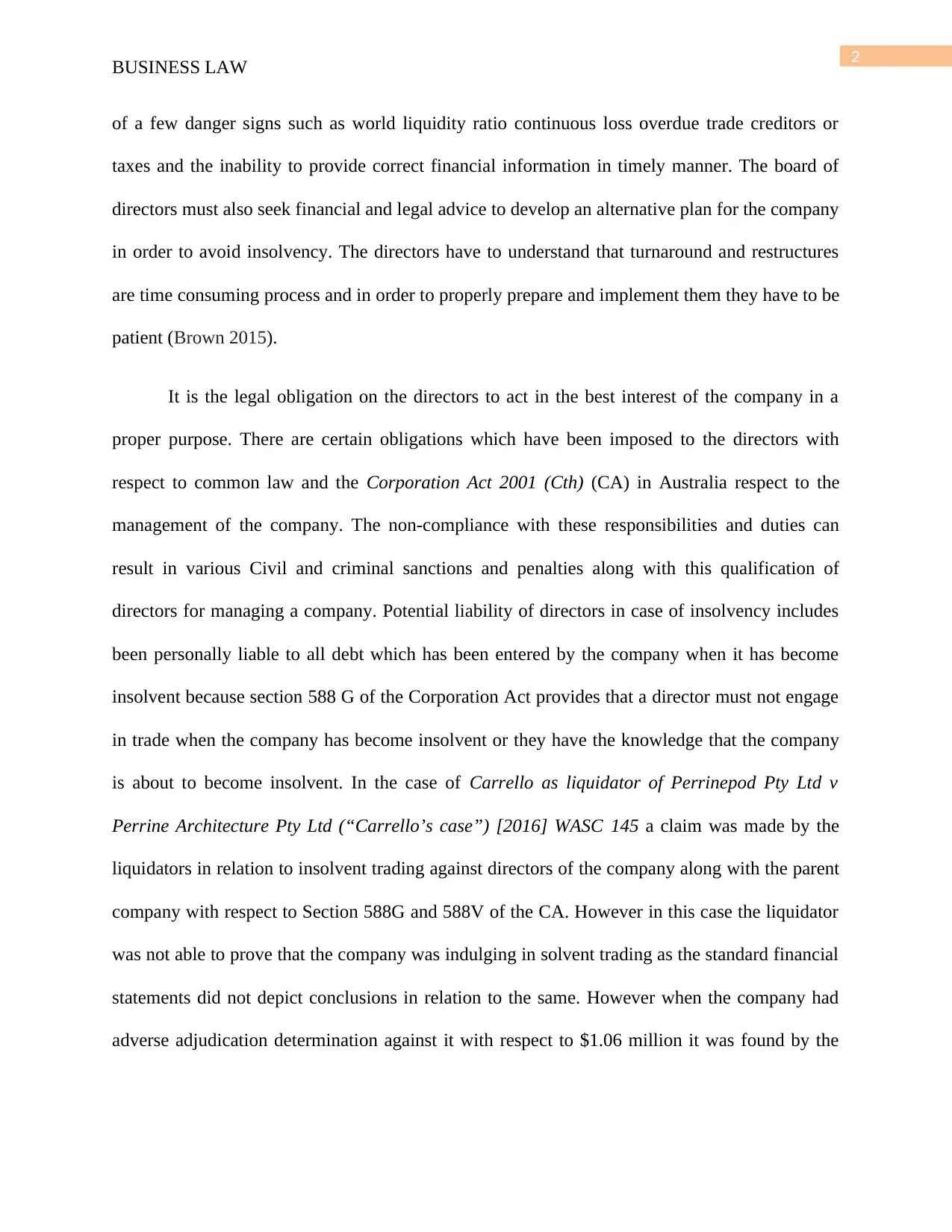
2
BUSINESS LAW
of a few danger signs such as world liquidity ratio continuous loss overdue trade creditors or
taxes and the inability to provide correct financial information in timely manner. The board of
directors must also seek financial and legal advice to develop an alternative plan for the company
in order to avoid insolvency. The directors have to understand that turnaround and restructures
are time consuming process and in order to properly prepare and implement them they have to be
patient (Brown 2015).
It is the legal obligation on the directors to act in the best interest of the company in a
proper purpose. There are certain obligations which have been imposed to the directors with
respect to common law and the Corporation Act 2001 (Cth) (CA) in Australia respect to the
management of the company. The non-compliance with these responsibilities and duties can
result in various Civil and criminal sanctions and penalties along with this qualification of
directors for managing a company. Potential liability of directors in case of insolvency includes
been personally liable to all debt which has been entered by the company when it has become
insolvent because section 588 G of the Corporation Act provides that a director must not engage
in trade when the company has become insolvent or they have the knowledge that the company
is about to become insolvent. In the case of Carrello as liquidator of Perrinepod Pty Ltd v
Perrine Architecture Pty Ltd (“Carrello’s case”) [2016] WASC 145 a claim was made by the
liquidators in relation to insolvent trading against directors of the company along with the parent
company with respect to Section 588G and 588V of the CA. However in this case the liquidator
was not able to prove that the company was indulging in solvent trading as the standard financial
statements did not depict conclusions in relation to the same. However when the company had
adverse adjudication determination against it with respect to $1.06 million it was found by the
BUSINESS LAW
of a few danger signs such as world liquidity ratio continuous loss overdue trade creditors or
taxes and the inability to provide correct financial information in timely manner. The board of
directors must also seek financial and legal advice to develop an alternative plan for the company
in order to avoid insolvency. The directors have to understand that turnaround and restructures
are time consuming process and in order to properly prepare and implement them they have to be
patient (Brown 2015).
It is the legal obligation on the directors to act in the best interest of the company in a
proper purpose. There are certain obligations which have been imposed to the directors with
respect to common law and the Corporation Act 2001 (Cth) (CA) in Australia respect to the
management of the company. The non-compliance with these responsibilities and duties can
result in various Civil and criminal sanctions and penalties along with this qualification of
directors for managing a company. Potential liability of directors in case of insolvency includes
been personally liable to all debt which has been entered by the company when it has become
insolvent because section 588 G of the Corporation Act provides that a director must not engage
in trade when the company has become insolvent or they have the knowledge that the company
is about to become insolvent. In the case of Carrello as liquidator of Perrinepod Pty Ltd v
Perrine Architecture Pty Ltd (“Carrello’s case”) [2016] WASC 145 a claim was made by the
liquidators in relation to insolvent trading against directors of the company along with the parent
company with respect to Section 588G and 588V of the CA. However in this case the liquidator
was not able to prove that the company was indulging in solvent trading as the standard financial
statements did not depict conclusions in relation to the same. However when the company had
adverse adjudication determination against it with respect to $1.06 million it was found by the
⊘ This is a preview!⊘
Do you want full access?
Subscribe today to unlock all pages.

Trusted by 1+ million students worldwide
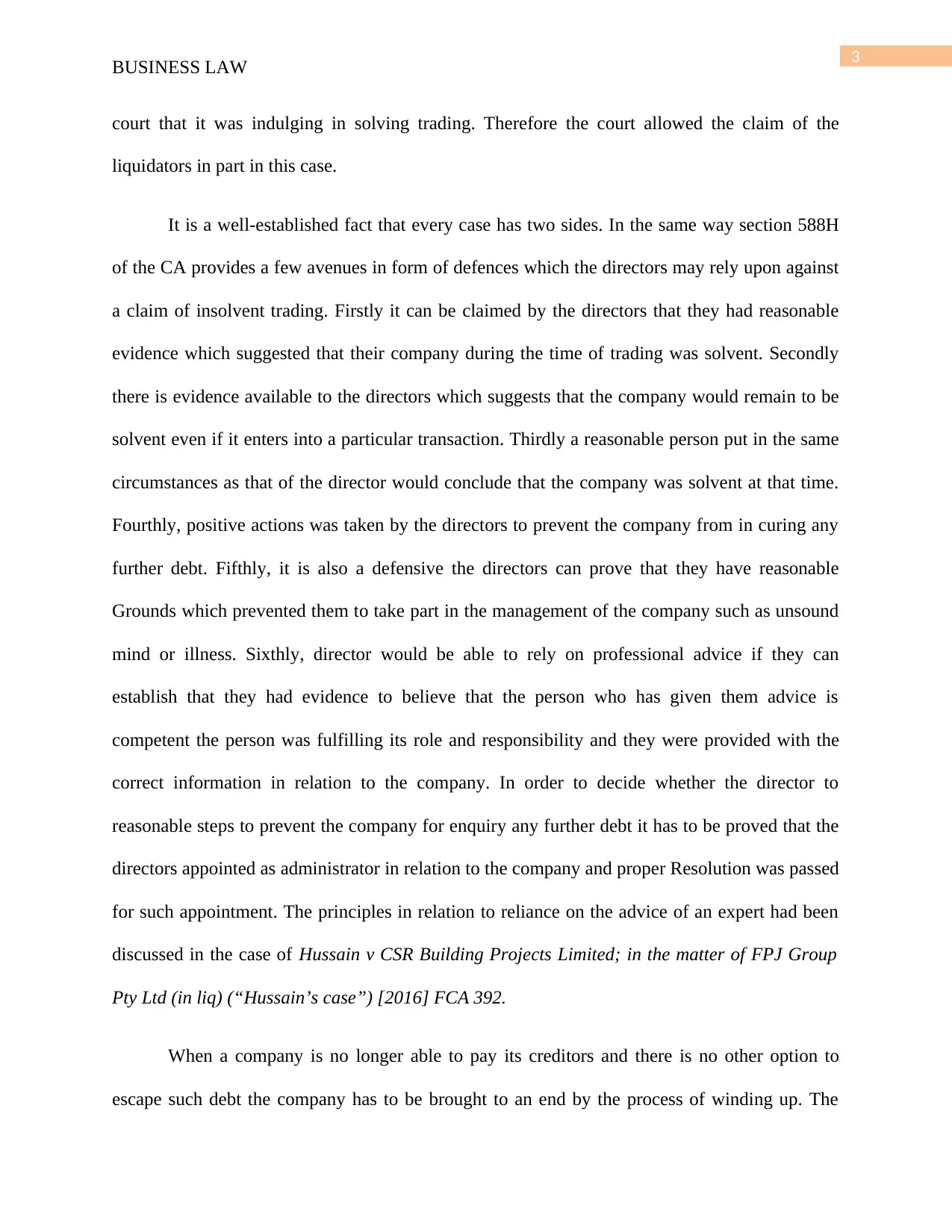
3
BUSINESS LAW
court that it was indulging in solving trading. Therefore the court allowed the claim of the
liquidators in part in this case.
It is a well-established fact that every case has two sides. In the same way section 588H
of the CA provides a few avenues in form of defences which the directors may rely upon against
a claim of insolvent trading. Firstly it can be claimed by the directors that they had reasonable
evidence which suggested that their company during the time of trading was solvent. Secondly
there is evidence available to the directors which suggests that the company would remain to be
solvent even if it enters into a particular transaction. Thirdly a reasonable person put in the same
circumstances as that of the director would conclude that the company was solvent at that time.
Fourthly, positive actions was taken by the directors to prevent the company from in curing any
further debt. Fifthly, it is also a defensive the directors can prove that they have reasonable
Grounds which prevented them to take part in the management of the company such as unsound
mind or illness. Sixthly, director would be able to rely on professional advice if they can
establish that they had evidence to believe that the person who has given them advice is
competent the person was fulfilling its role and responsibility and they were provided with the
correct information in relation to the company. In order to decide whether the director to
reasonable steps to prevent the company for enquiry any further debt it has to be proved that the
directors appointed as administrator in relation to the company and proper Resolution was passed
for such appointment. The principles in relation to reliance on the advice of an expert had been
discussed in the case of Hussain v CSR Building Projects Limited; in the matter of FPJ Group
Pty Ltd (in liq) (“Hussain’s case”) [2016] FCA 392.
When a company is no longer able to pay its creditors and there is no other option to
escape such debt the company has to be brought to an end by the process of winding up. The
BUSINESS LAW
court that it was indulging in solving trading. Therefore the court allowed the claim of the
liquidators in part in this case.
It is a well-established fact that every case has two sides. In the same way section 588H
of the CA provides a few avenues in form of defences which the directors may rely upon against
a claim of insolvent trading. Firstly it can be claimed by the directors that they had reasonable
evidence which suggested that their company during the time of trading was solvent. Secondly
there is evidence available to the directors which suggests that the company would remain to be
solvent even if it enters into a particular transaction. Thirdly a reasonable person put in the same
circumstances as that of the director would conclude that the company was solvent at that time.
Fourthly, positive actions was taken by the directors to prevent the company from in curing any
further debt. Fifthly, it is also a defensive the directors can prove that they have reasonable
Grounds which prevented them to take part in the management of the company such as unsound
mind or illness. Sixthly, director would be able to rely on professional advice if they can
establish that they had evidence to believe that the person who has given them advice is
competent the person was fulfilling its role and responsibility and they were provided with the
correct information in relation to the company. In order to decide whether the director to
reasonable steps to prevent the company for enquiry any further debt it has to be proved that the
directors appointed as administrator in relation to the company and proper Resolution was passed
for such appointment. The principles in relation to reliance on the advice of an expert had been
discussed in the case of Hussain v CSR Building Projects Limited; in the matter of FPJ Group
Pty Ltd (in liq) (“Hussain’s case”) [2016] FCA 392.
When a company is no longer able to pay its creditors and there is no other option to
escape such debt the company has to be brought to an end by the process of winding up. The
Paraphrase This Document
Need a fresh take? Get an instant paraphrase of this document with our AI Paraphraser
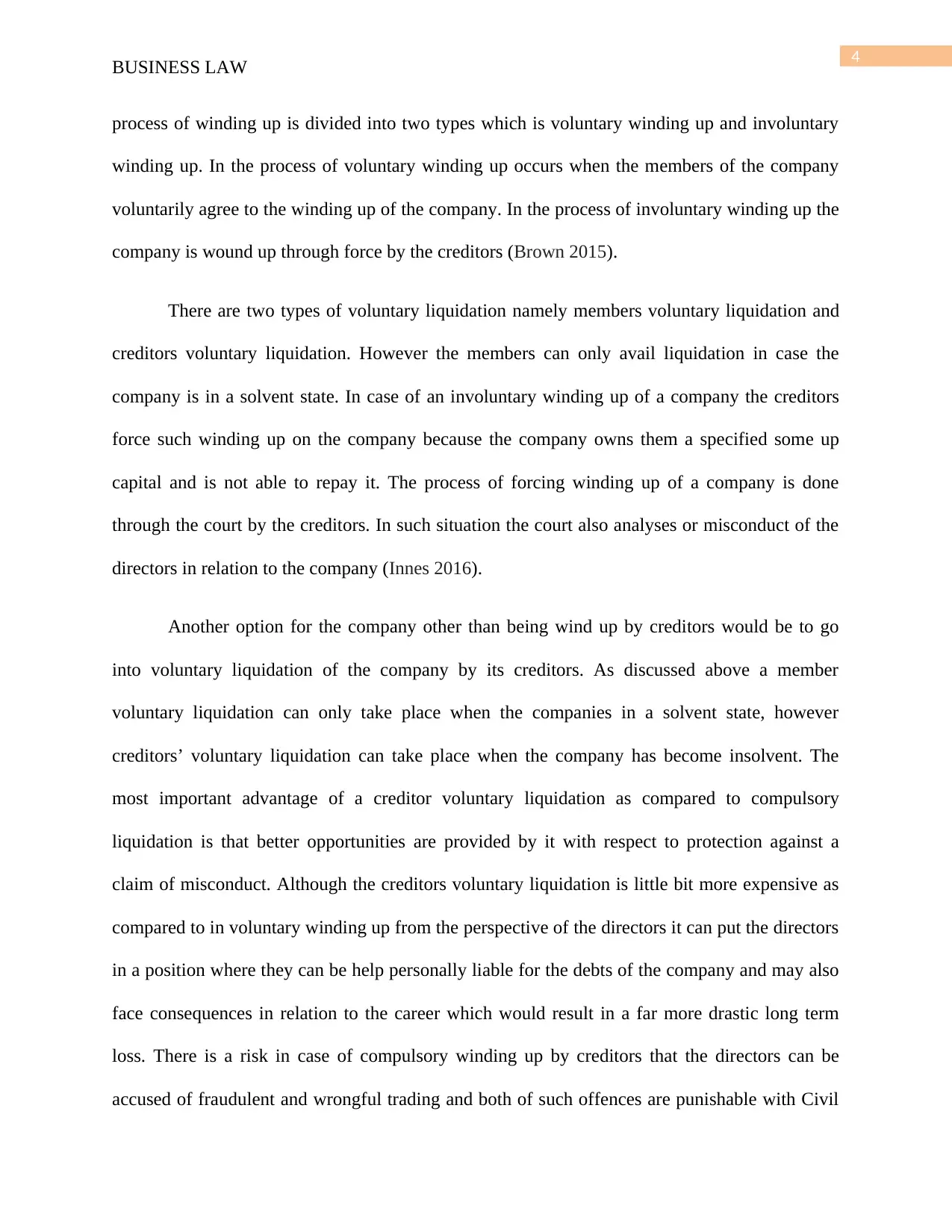
4
BUSINESS LAW
process of winding up is divided into two types which is voluntary winding up and involuntary
winding up. In the process of voluntary winding up occurs when the members of the company
voluntarily agree to the winding up of the company. In the process of involuntary winding up the
company is wound up through force by the creditors (Brown 2015).
There are two types of voluntary liquidation namely members voluntary liquidation and
creditors voluntary liquidation. However the members can only avail liquidation in case the
company is in a solvent state. In case of an involuntary winding up of a company the creditors
force such winding up on the company because the company owns them a specified some up
capital and is not able to repay it. The process of forcing winding up of a company is done
through the court by the creditors. In such situation the court also analyses or misconduct of the
directors in relation to the company (Innes 2016).
Another option for the company other than being wind up by creditors would be to go
into voluntary liquidation of the company by its creditors. As discussed above a member
voluntary liquidation can only take place when the companies in a solvent state, however
creditors’ voluntary liquidation can take place when the company has become insolvent. The
most important advantage of a creditor voluntary liquidation as compared to compulsory
liquidation is that better opportunities are provided by it with respect to protection against a
claim of misconduct. Although the creditors voluntary liquidation is little bit more expensive as
compared to in voluntary winding up from the perspective of the directors it can put the directors
in a position where they can be help personally liable for the debts of the company and may also
face consequences in relation to the career which would result in a far more drastic long term
loss. There is a risk in case of compulsory winding up by creditors that the directors can be
accused of fraudulent and wrongful trading and both of such offences are punishable with Civil
BUSINESS LAW
process of winding up is divided into two types which is voluntary winding up and involuntary
winding up. In the process of voluntary winding up occurs when the members of the company
voluntarily agree to the winding up of the company. In the process of involuntary winding up the
company is wound up through force by the creditors (Brown 2015).
There are two types of voluntary liquidation namely members voluntary liquidation and
creditors voluntary liquidation. However the members can only avail liquidation in case the
company is in a solvent state. In case of an involuntary winding up of a company the creditors
force such winding up on the company because the company owns them a specified some up
capital and is not able to repay it. The process of forcing winding up of a company is done
through the court by the creditors. In such situation the court also analyses or misconduct of the
directors in relation to the company (Innes 2016).
Another option for the company other than being wind up by creditors would be to go
into voluntary liquidation of the company by its creditors. As discussed above a member
voluntary liquidation can only take place when the companies in a solvent state, however
creditors’ voluntary liquidation can take place when the company has become insolvent. The
most important advantage of a creditor voluntary liquidation as compared to compulsory
liquidation is that better opportunities are provided by it with respect to protection against a
claim of misconduct. Although the creditors voluntary liquidation is little bit more expensive as
compared to in voluntary winding up from the perspective of the directors it can put the directors
in a position where they can be help personally liable for the debts of the company and may also
face consequences in relation to the career which would result in a far more drastic long term
loss. There is a risk in case of compulsory winding up by creditors that the directors can be
accused of fraudulent and wrongful trading and both of such offences are punishable with Civil
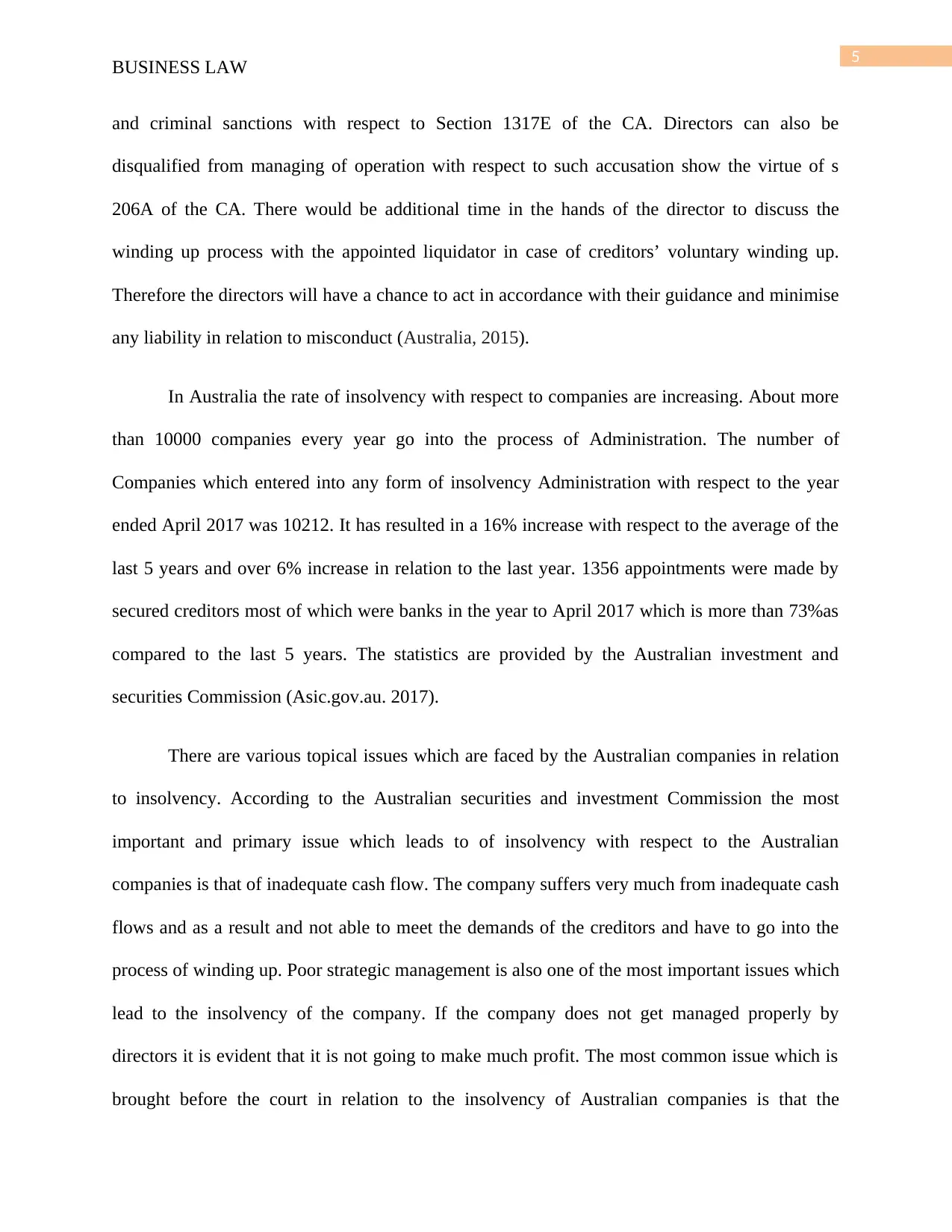
5
BUSINESS LAW
and criminal sanctions with respect to Section 1317E of the CA. Directors can also be
disqualified from managing of operation with respect to such accusation show the virtue of s
206A of the CA. There would be additional time in the hands of the director to discuss the
winding up process with the appointed liquidator in case of creditors’ voluntary winding up.
Therefore the directors will have a chance to act in accordance with their guidance and minimise
any liability in relation to misconduct (Australia, 2015).
In Australia the rate of insolvency with respect to companies are increasing. About more
than 10000 companies every year go into the process of Administration. The number of
Companies which entered into any form of insolvency Administration with respect to the year
ended April 2017 was 10212. It has resulted in a 16% increase with respect to the average of the
last 5 years and over 6% increase in relation to the last year. 1356 appointments were made by
secured creditors most of which were banks in the year to April 2017 which is more than 73%as
compared to the last 5 years. The statistics are provided by the Australian investment and
securities Commission (Asic.gov.au. 2017).
There are various topical issues which are faced by the Australian companies in relation
to insolvency. According to the Australian securities and investment Commission the most
important and primary issue which leads to of insolvency with respect to the Australian
companies is that of inadequate cash flow. The company suffers very much from inadequate cash
flows and as a result and not able to meet the demands of the creditors and have to go into the
process of winding up. Poor strategic management is also one of the most important issues which
lead to the insolvency of the company. If the company does not get managed properly by
directors it is evident that it is not going to make much profit. The most common issue which is
brought before the court in relation to the insolvency of Australian companies is that the
BUSINESS LAW
and criminal sanctions with respect to Section 1317E of the CA. Directors can also be
disqualified from managing of operation with respect to such accusation show the virtue of s
206A of the CA. There would be additional time in the hands of the director to discuss the
winding up process with the appointed liquidator in case of creditors’ voluntary winding up.
Therefore the directors will have a chance to act in accordance with their guidance and minimise
any liability in relation to misconduct (Australia, 2015).
In Australia the rate of insolvency with respect to companies are increasing. About more
than 10000 companies every year go into the process of Administration. The number of
Companies which entered into any form of insolvency Administration with respect to the year
ended April 2017 was 10212. It has resulted in a 16% increase with respect to the average of the
last 5 years and over 6% increase in relation to the last year. 1356 appointments were made by
secured creditors most of which were banks in the year to April 2017 which is more than 73%as
compared to the last 5 years. The statistics are provided by the Australian investment and
securities Commission (Asic.gov.au. 2017).
There are various topical issues which are faced by the Australian companies in relation
to insolvency. According to the Australian securities and investment Commission the most
important and primary issue which leads to of insolvency with respect to the Australian
companies is that of inadequate cash flow. The company suffers very much from inadequate cash
flows and as a result and not able to meet the demands of the creditors and have to go into the
process of winding up. Poor strategic management is also one of the most important issues which
lead to the insolvency of the company. If the company does not get managed properly by
directors it is evident that it is not going to make much profit. The most common issue which is
brought before the court in relation to the insolvency of Australian companies is that the
⊘ This is a preview!⊘
Do you want full access?
Subscribe today to unlock all pages.

Trusted by 1+ million students worldwide
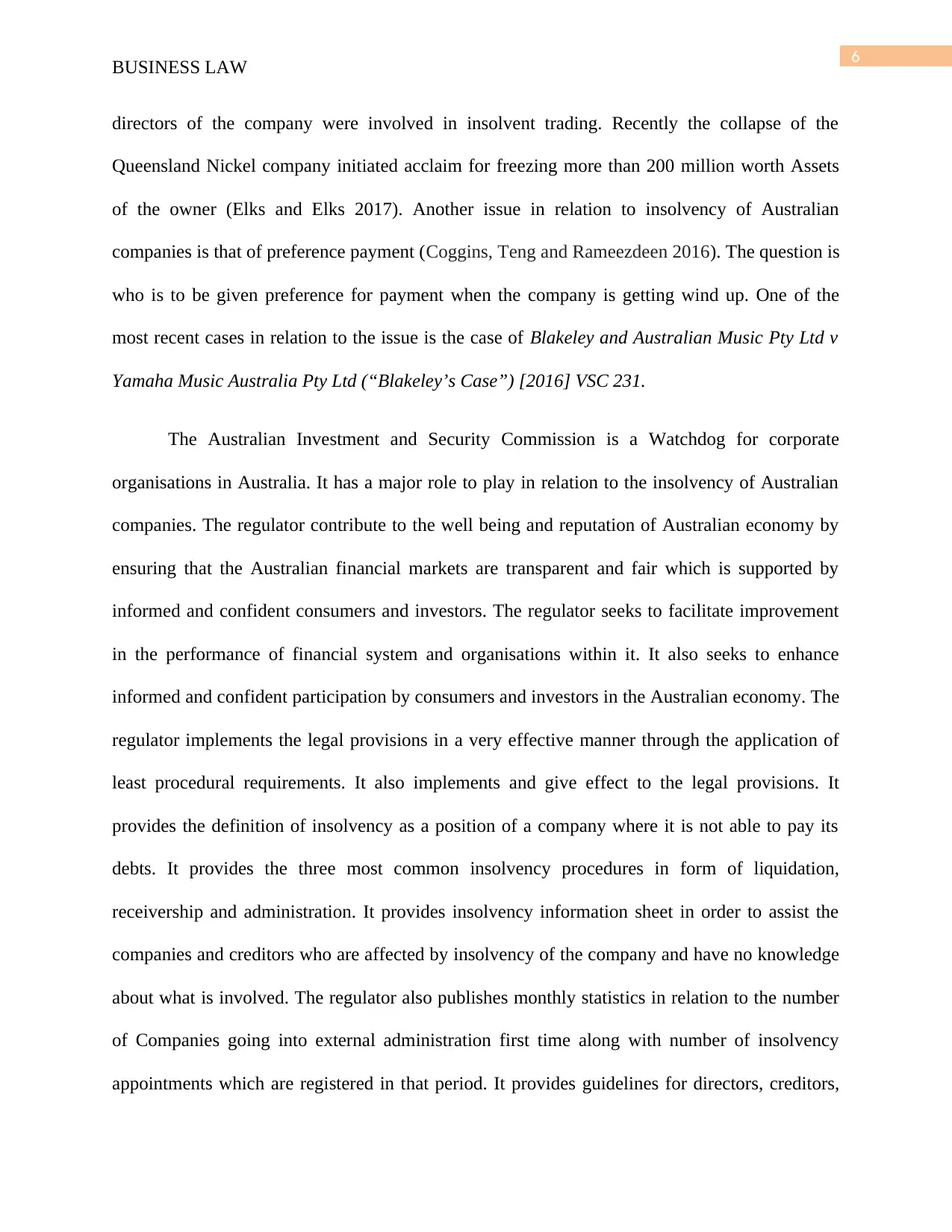
6
BUSINESS LAW
directors of the company were involved in insolvent trading. Recently the collapse of the
Queensland Nickel company initiated acclaim for freezing more than 200 million worth Assets
of the owner (Elks and Elks 2017). Another issue in relation to insolvency of Australian
companies is that of preference payment (Coggins, Teng and Rameezdeen 2016). The question is
who is to be given preference for payment when the company is getting wind up. One of the
most recent cases in relation to the issue is the case of Blakeley and Australian Music Pty Ltd v
Yamaha Music Australia Pty Ltd (“Blakeley’s Case”) [2016] VSC 231.
The Australian Investment and Security Commission is a Watchdog for corporate
organisations in Australia. It has a major role to play in relation to the insolvency of Australian
companies. The regulator contribute to the well being and reputation of Australian economy by
ensuring that the Australian financial markets are transparent and fair which is supported by
informed and confident consumers and investors. The regulator seeks to facilitate improvement
in the performance of financial system and organisations within it. It also seeks to enhance
informed and confident participation by consumers and investors in the Australian economy. The
regulator implements the legal provisions in a very effective manner through the application of
least procedural requirements. It also implements and give effect to the legal provisions. It
provides the definition of insolvency as a position of a company where it is not able to pay its
debts. It provides the three most common insolvency procedures in form of liquidation,
receivership and administration. It provides insolvency information sheet in order to assist the
companies and creditors who are affected by insolvency of the company and have no knowledge
about what is involved. The regulator also publishes monthly statistics in relation to the number
of Companies going into external administration first time along with number of insolvency
appointments which are registered in that period. It provides guidelines for directors, creditors,
BUSINESS LAW
directors of the company were involved in insolvent trading. Recently the collapse of the
Queensland Nickel company initiated acclaim for freezing more than 200 million worth Assets
of the owner (Elks and Elks 2017). Another issue in relation to insolvency of Australian
companies is that of preference payment (Coggins, Teng and Rameezdeen 2016). The question is
who is to be given preference for payment when the company is getting wind up. One of the
most recent cases in relation to the issue is the case of Blakeley and Australian Music Pty Ltd v
Yamaha Music Australia Pty Ltd (“Blakeley’s Case”) [2016] VSC 231.
The Australian Investment and Security Commission is a Watchdog for corporate
organisations in Australia. It has a major role to play in relation to the insolvency of Australian
companies. The regulator contribute to the well being and reputation of Australian economy by
ensuring that the Australian financial markets are transparent and fair which is supported by
informed and confident consumers and investors. The regulator seeks to facilitate improvement
in the performance of financial system and organisations within it. It also seeks to enhance
informed and confident participation by consumers and investors in the Australian economy. The
regulator implements the legal provisions in a very effective manner through the application of
least procedural requirements. It also implements and give effect to the legal provisions. It
provides the definition of insolvency as a position of a company where it is not able to pay its
debts. It provides the three most common insolvency procedures in form of liquidation,
receivership and administration. It provides insolvency information sheet in order to assist the
companies and creditors who are affected by insolvency of the company and have no knowledge
about what is involved. The regulator also publishes monthly statistics in relation to the number
of Companies going into external administration first time along with number of insolvency
appointments which are registered in that period. It provides guidelines for directors, creditors,
Paraphrase This Document
Need a fresh take? Get an instant paraphrase of this document with our AI Paraphraser

7
BUSINESS LAW
employees, investors, shareholders and liquidators in case they come into contact with
insolvency (Asic.gov.au. 2017).
BUSINESS LAW
employees, investors, shareholders and liquidators in case they come into contact with
insolvency (Asic.gov.au. 2017).
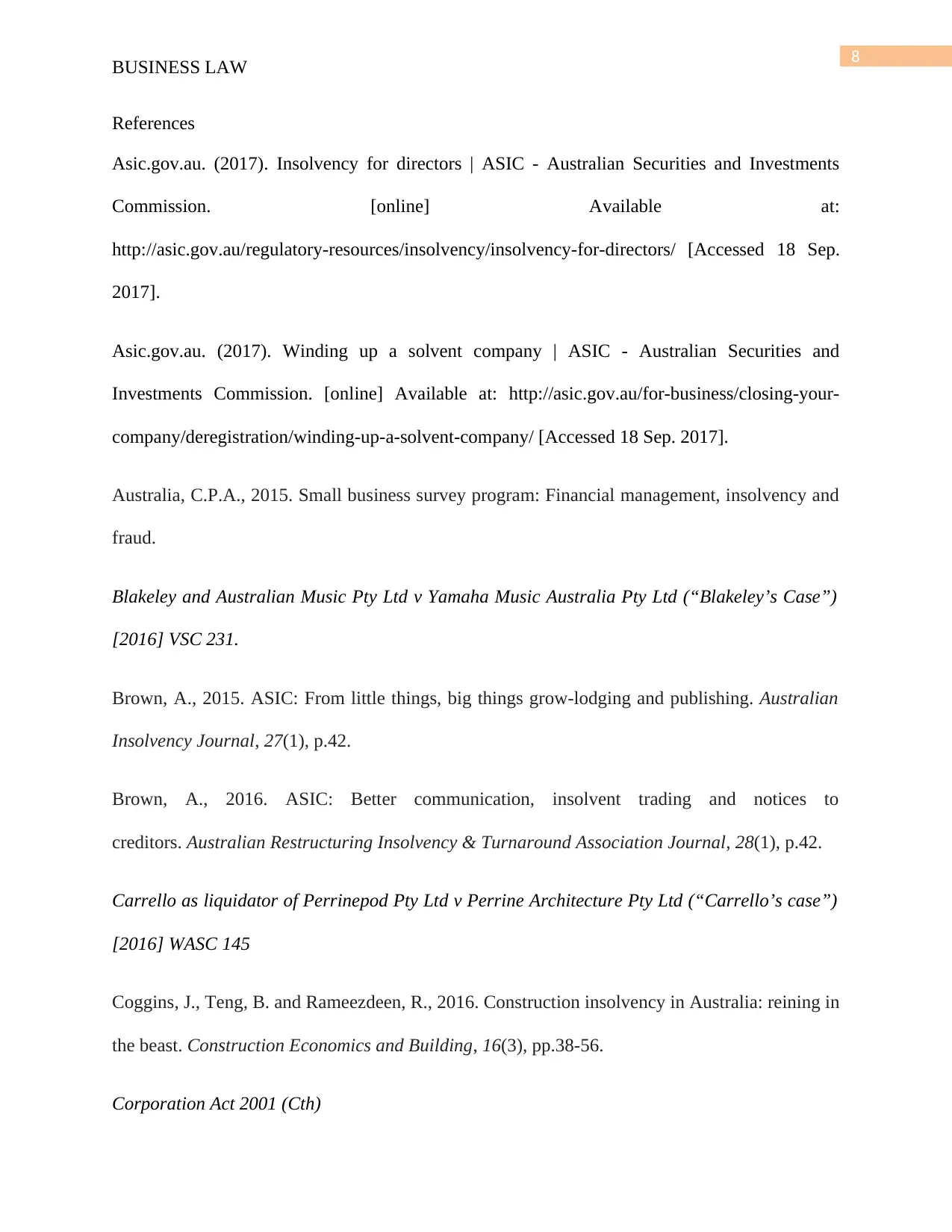
8
BUSINESS LAW
References
Asic.gov.au. (2017). Insolvency for directors | ASIC - Australian Securities and Investments
Commission. [online] Available at:
http://asic.gov.au/regulatory-resources/insolvency/insolvency-for-directors/ [Accessed 18 Sep.
2017].
Asic.gov.au. (2017). Winding up a solvent company | ASIC - Australian Securities and
Investments Commission. [online] Available at: http://asic.gov.au/for-business/closing-your-
company/deregistration/winding-up-a-solvent-company/ [Accessed 18 Sep. 2017].
Australia, C.P.A., 2015. Small business survey program: Financial management, insolvency and
fraud.
Blakeley and Australian Music Pty Ltd v Yamaha Music Australia Pty Ltd (“Blakeley’s Case”)
[2016] VSC 231.
Brown, A., 2015. ASIC: From little things, big things grow-lodging and publishing. Australian
Insolvency Journal, 27(1), p.42.
Brown, A., 2016. ASIC: Better communication, insolvent trading and notices to
creditors. Australian Restructuring Insolvency & Turnaround Association Journal, 28(1), p.42.
Carrello as liquidator of Perrinepod Pty Ltd v Perrine Architecture Pty Ltd (“Carrello’s case”)
[2016] WASC 145
Coggins, J., Teng, B. and Rameezdeen, R., 2016. Construction insolvency in Australia: reining in
the beast. Construction Economics and Building, 16(3), pp.38-56.
Corporation Act 2001 (Cth)
BUSINESS LAW
References
Asic.gov.au. (2017). Insolvency for directors | ASIC - Australian Securities and Investments
Commission. [online] Available at:
http://asic.gov.au/regulatory-resources/insolvency/insolvency-for-directors/ [Accessed 18 Sep.
2017].
Asic.gov.au. (2017). Winding up a solvent company | ASIC - Australian Securities and
Investments Commission. [online] Available at: http://asic.gov.au/for-business/closing-your-
company/deregistration/winding-up-a-solvent-company/ [Accessed 18 Sep. 2017].
Australia, C.P.A., 2015. Small business survey program: Financial management, insolvency and
fraud.
Blakeley and Australian Music Pty Ltd v Yamaha Music Australia Pty Ltd (“Blakeley’s Case”)
[2016] VSC 231.
Brown, A., 2015. ASIC: From little things, big things grow-lodging and publishing. Australian
Insolvency Journal, 27(1), p.42.
Brown, A., 2016. ASIC: Better communication, insolvent trading and notices to
creditors. Australian Restructuring Insolvency & Turnaround Association Journal, 28(1), p.42.
Carrello as liquidator of Perrinepod Pty Ltd v Perrine Architecture Pty Ltd (“Carrello’s case”)
[2016] WASC 145
Coggins, J., Teng, B. and Rameezdeen, R., 2016. Construction insolvency in Australia: reining in
the beast. Construction Economics and Building, 16(3), pp.38-56.
Corporation Act 2001 (Cth)
⊘ This is a preview!⊘
Do you want full access?
Subscribe today to unlock all pages.

Trusted by 1+ million students worldwide
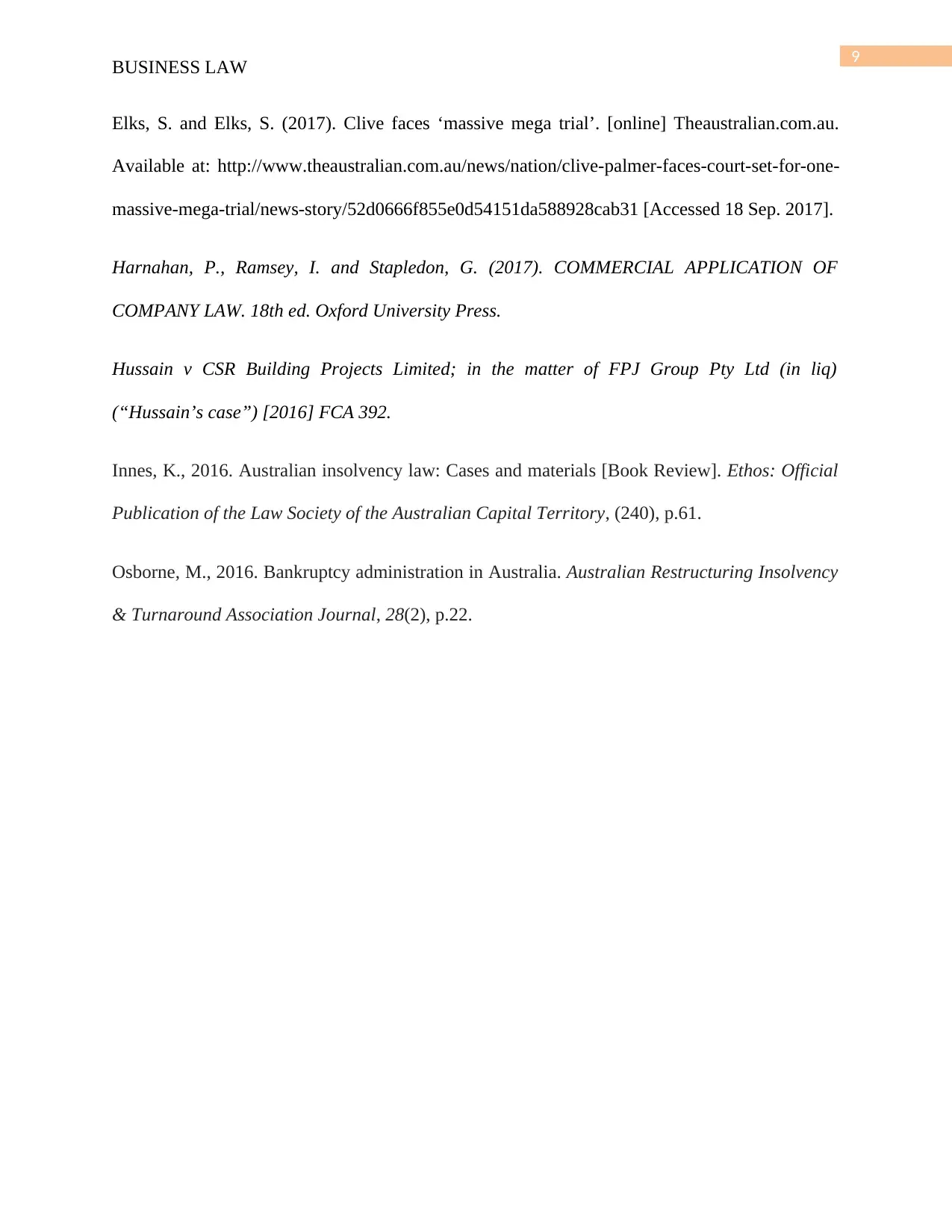
9
BUSINESS LAW
Elks, S. and Elks, S. (2017). Clive faces ‘massive mega trial’. [online] Theaustralian.com.au.
Available at: http://www.theaustralian.com.au/news/nation/clive-palmer-faces-court-set-for-one-
massive-mega-trial/news-story/52d0666f855e0d54151da588928cab31 [Accessed 18 Sep. 2017].
Harnahan, P., Ramsey, I. and Stapledon, G. (2017). COMMERCIAL APPLICATION OF
COMPANY LAW. 18th ed. Oxford University Press.
Hussain v CSR Building Projects Limited; in the matter of FPJ Group Pty Ltd (in liq)
(“Hussain’s case”) [2016] FCA 392.
Innes, K., 2016. Australian insolvency law: Cases and materials [Book Review]. Ethos: Official
Publication of the Law Society of the Australian Capital Territory, (240), p.61.
Osborne, M., 2016. Bankruptcy administration in Australia. Australian Restructuring Insolvency
& Turnaround Association Journal, 28(2), p.22.
BUSINESS LAW
Elks, S. and Elks, S. (2017). Clive faces ‘massive mega trial’. [online] Theaustralian.com.au.
Available at: http://www.theaustralian.com.au/news/nation/clive-palmer-faces-court-set-for-one-
massive-mega-trial/news-story/52d0666f855e0d54151da588928cab31 [Accessed 18 Sep. 2017].
Harnahan, P., Ramsey, I. and Stapledon, G. (2017). COMMERCIAL APPLICATION OF
COMPANY LAW. 18th ed. Oxford University Press.
Hussain v CSR Building Projects Limited; in the matter of FPJ Group Pty Ltd (in liq)
(“Hussain’s case”) [2016] FCA 392.
Innes, K., 2016. Australian insolvency law: Cases and materials [Book Review]. Ethos: Official
Publication of the Law Society of the Australian Capital Territory, (240), p.61.
Osborne, M., 2016. Bankruptcy administration in Australia. Australian Restructuring Insolvency
& Turnaround Association Journal, 28(2), p.22.
1 out of 10
Related Documents
Your All-in-One AI-Powered Toolkit for Academic Success.
+13062052269
info@desklib.com
Available 24*7 on WhatsApp / Email
![[object Object]](/_next/static/media/star-bottom.7253800d.svg)
Unlock your academic potential
Copyright © 2020–2025 A2Z Services. All Rights Reserved. Developed and managed by ZUCOL.





